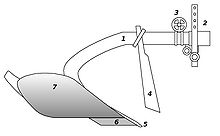Sech (agricultural engineering)
The coulter (also called ploughshare, plow knife, knife coulter, pre-cutter or skimmer) is a so-called preparatory tool for the plow , which cuts the ground vertically in front of the ploughshare and usually has the shape of a long, slightly curved knife .
History and function
Seche were already used in antiquity and, according to Pliny the Elder, were Ä. common in Raetia. Since the Middle Ages , a six has also been part of the plow in Central Europe. The vertical cutting of the soil to be plowed by a sharp coulter, in contrast to the separation by the blunt mouldboard leading edge, reduces the pulling force required when plowing, and the work result is better thanks to the cleanly separated furrow wall. The more cleanly cleared furrow also makes it easier to keep track of the trailer plow or the tractor pulling the plow.
The working depth of the six is to be set at least “root-deep” to cleanly cut off the earth bar to be plowed. In cohesive soils, the six is therefore positioned almost to the furrow depth, in less cohesive soils the six point can also be set higher. To protect the front edge of the mouldboard, the six should point a few millimeters more than this towards the unploughed land.
In addition to the knife-shaped coulter, there are also round, rotating coulter, so-called disc coulters. These require less traction than knife coulters. Today, multi-blade plows often only have a coulter on the last plow body (for reasons of cost). When plowing grassland , however, a six in front of each body makes sense.
Medieval iconography
The Pflugsech can often be found on rural stone crosses and cross stones from the Middle Ages, but also on grave slabs, craftsmen's coats of arms and local coats of arms.
Pflugsech on a medieval stone cross in the Schwalm
Individual evidence
- ↑ Sech in: Propylaen Technikgeschichte, Volume 1, page 208 ff. And 380 ff. And Volume 3, p. 98 ff.
literature
- Bodo Frahm, BGJ Agrarwirtschaft, 4th edition, Ulmer, Stuttgart, 1980, 1991, ISBN 3-8001-1049-0 , page 451
- Paul Schweigmann, Agricultural machinery and their maintenance, Pfanneberg, Gießen, 1955, Reprint: Bulldog Press, Limburg ad Lahn, 1993, ISBN 3-9803332-1-3 , p. 21 ff.
- FK Azzola, H. Bormuth, The plow as a sign of rural status on stone crosses and other small monuments, collective work = contributions to the exploration of the Odenwald and its peripheral landscapes, Volume 2 Breuberg-Neustadt, 1977, page 208 f.




